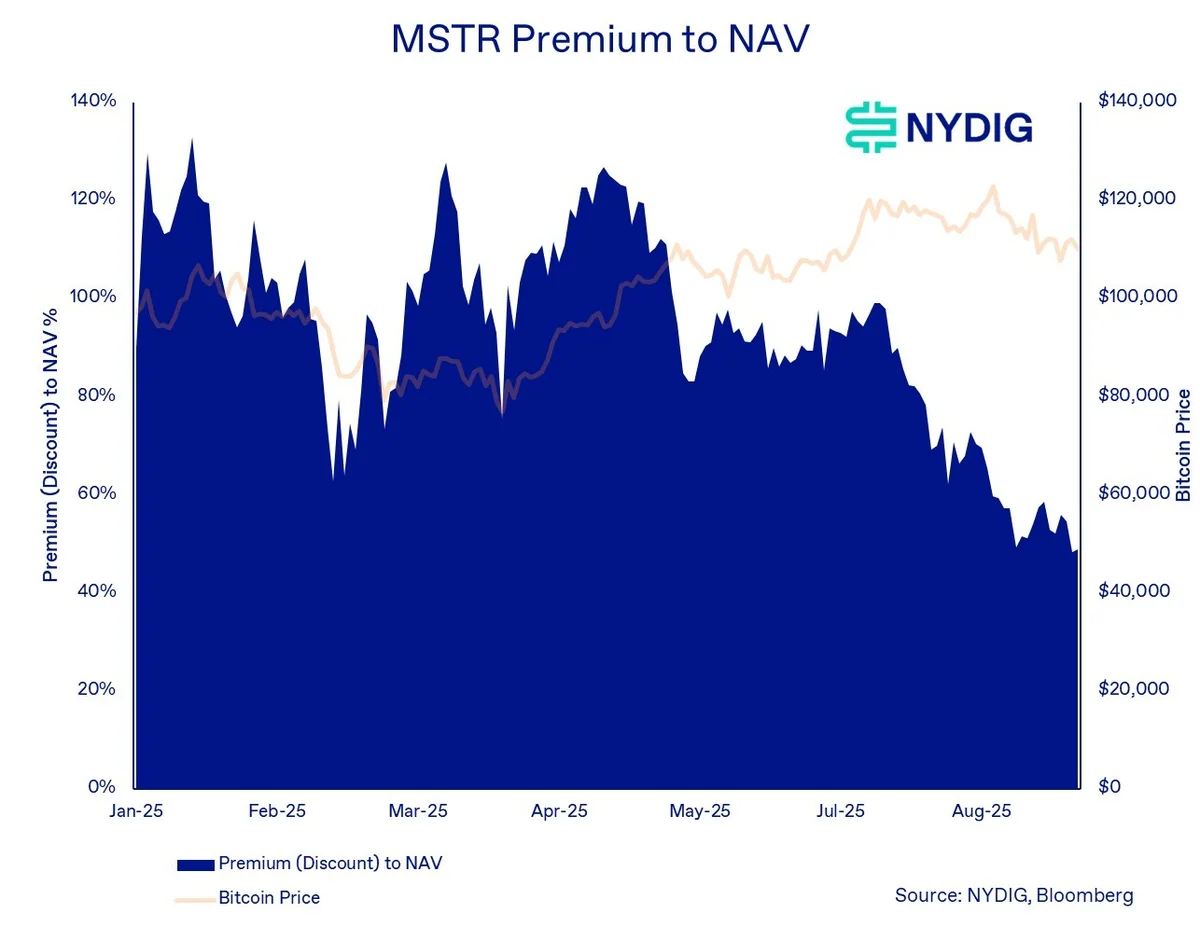Bitcoin Treasury Firms May Face Turbulence as Share Price-to-NAV Gaps Narrow, NYDIG Says
BTC
BTC/USDT
$11,976,432,583.07
$92,519.95 / $90,236.00
Change: $2,283.95 (2.53%)
+0.0033%
Longs pay
Contents
Bitcoin treasury premiums are narrowing as the gap between share prices and net asset value (NAV) compresses; NYDIG warns this could cause volatility for digital asset treasury firms unless companies use measures like stock buybacks and reserved funds to support shares.
-
Premium compression across DATs: NAV gaps are shrinking, increasing downside risk.
-
NYDIG cites investor anxiety, share issuance, and limited strategy differentiation as drivers.
-
Bitcoin holdings peaked near 840,000 BTC; monthly purchases slowed and average buy sizes fell sharply.
Bitcoin treasury premiums narrow as NAV gaps compress; NYDIG advises buybacks and reserve funding to stabilize DAT shares — read the holdings and strategy data now.
NYDIG analysis flags potential turbulence as the premium between share prices and asset values of Bitcoin holding companies narrows, recommending buybacks and reserved capital to stabilize DAT valuations.
What are Bitcoin treasury premiums and why do they matter?
Bitcoin treasury premiums refer to the difference between a publicly traded treasury firm’s share price and the net asset value (NAV) of the crypto it holds. Premiums matter because widening or compressing gaps signal investor sentiment and can foreshadow rapid selling or buying when shares become tradable.

How is NAV compression affecting DAT share prices?
NYDIG global head of research Greg Cipolaro reports that the gap between stock prices and NAV for major Bitcoin buyers “continues to compress” even as Bitcoin hits new highs. Causes include anticipated supply unlocks, increased share issuance, investor profit-taking, and limited differentiation across treasury strategies.
What scale of holdings and purchase changes are we seeing?
CryptoQuant data shows public treasury holdings reached a peak of about 840,000 BTC this year, with one firm holding roughly 76% (≈637,000 BTC) and the rest spread across 32 other companies. Monthly purchases slowed in August, with average purchase sizes dropping sharply.

For instance, Strategy’s average purchase size fell to about 1,200 BTC in August from a 2025 peak near 14,000 BTC. Other firms bought 86% less Bitcoin compared to their March 2025 high of 2,400 BTC per transaction. This slowdown reduced monthly growth: Strategy’s rate dropped to 5% in the most recent month versus 44% at the end of 2024.
How can share buybacks and corporate actions reduce volatility?
Cipolaro recommends that digital asset treasury firms reserve some raised capital for stock buybacks to reduce supply and support share prices. Buybacks can be the most straightforward tool when shares trade at or below NAV and can help prevent cascades of selling when shares become freely tradable.
What practical steps should DAT management teams take?
- Reserve buyback funds: Set aside a clear percentage of proceeds from fundraises to deploy for buybacks.
- Limit dilutive issuance: Avoid excessive share issuance that can compress premiums further.
- Communicate strategy: Provide transparent roadmaps for treasury management and liquidity plans to reduce investor anxiety.
When could market turbulence occur for these companies?
Market turbulence is most likely around events that increase available float — IPOs, listings after financing rounds, or announced unlocks. Cipolaro warns a “substantial wave of selling” could occur if existing shareholders seek liquidity once restrictions lift.
Frequently Asked Questions
Why did NYDIG flag premium compression now?
NYDIG observed narrowing premiums despite Bitcoin price gains. They attributed the compression to investor worry over supply unlocks, changing corporate objectives, tangible increases in share issuance, profit-taking, and limited strategic differentiation across DATs.
Are DATs still increasing Bitcoin holdings?
Holdings peaked this year at about 840,000 BTC, but recent data shows buying slowed in August with fewer BTC per transaction and reduced monthly growth rates for many firms.
Will buybacks fully solve the premium compression?
Buybacks can materially support share prices by reducing supply, but long-term resolution requires clearer corporate strategies, controlled issuance, and consistent buying programs aligned with treasury objectives.
Key Takeaways
- Premiums are compressing: NAV-to-share price gaps have narrowed, increasing downside risk if shares unlock.
- Actionable advice: Reserve funds for buybacks, limit dilutive issuance, and clarify treasury strategies.
- Data-driven context: Public treasury holdings peaked near 840,000 BTC; purchases slowed and average transaction sizes fell sharply in August.
Conclusion
Bitcoin treasury premiums are narrowing as NAV compression intensifies across digital asset treasury firms. NYDIG recommends buybacks and reserved capital to stabilize shares, while CryptoQuant data highlights a slowdown in purchases and peak holdings. Market participants should monitor supply unlocks and corporate issuance plans closely. For continued coverage, follow COINOTAG for updates and data-led analysis.
Comments
Yorumlar
Other Articles
Bitcoin Surges to $93,888: How Venezuela-US Tensions Triggered a Crypto Rally
January 5, 2026 at 07:04 AM UTC
Bitcoin Trades $85K-$90K Range Amid Rising Volatility and ETF Outflows
December 31, 2025 at 10:34 PM UTC
Bitwise Files for 11 Altcoin ETFs Including AAVE, UNI Amid SOL, XRP Muted Gains
December 31, 2025 at 08:47 PM UTC

